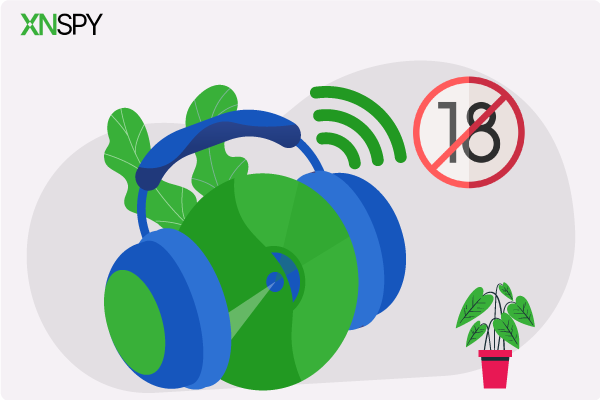The complete monitoring experience for your phone
Get XNSPY and start tracking calls, texts, multimedia, locations and more on any phone!
Get Started Now Live DemoToday, children do not even turn 10 months old, but more than hundreds of their photos and other details are being uploaded to social media. The funny part is that the photos are uploaded by no one other than their parents and without any consent or check.
The temptation to post photos of your child, particularly the first one, is hard to resist. You want to capture their every gesture and mischief and share them with almost everyone, whether it is their first birthday, their first time walking, or their first time at the seashore.
Surprisingly, even when the kids are older, most parents still share hundreds of photos of their children without applying any privacy settings.
This has given rise to the term ‘Sharenting’
What is Sharenting?
Parents sharing images, news, or other personal details of their children online is called ‘sharenting.’ The term combines two words, ‘sharing’ and ‘parenting,’ and was first used in an article in 2012 in the Wall Street Journal.
The moment social media went mainstream, sharenting was bound to happen sooner or later. People like ourselves often crave attention and approval from not only our relatives and friends but also well-known acquaintances.
Furthermore, apps such as Facebook and Instagram make it all the more convenient for parents to develop sharenting habits. You not only post pictures of your child but also add captions and write stories, hoping fellow parents will find them valuable and relatable.
The Sharent Trap
In today’s digital landscape, parents have much to worry about and are repeatedly reminded to monitor their kids’ online activities. But what if the danger to the child’s online safety does not come from their friends, peers, or strangers on social media?
Have you ever realized that the danger lies not in the social media activity they engage in but more to do with yours?
Sharenting has progressed from merely a buzzword and is now gaining traction in many households. Many children have digital footprints before they reach age 2, and by 5, they have more than thousands of images of them being shared online.
Experts say that by 2030, more than 7 million cases of identity fraud will come from sharenting.
The parents’ intention may seem loving, but there is no way to know how the kids react. There are several instances where the children seem embarrassed and ask their parents to delete the past posts.
Much like adults, children tend to suffer emotionally and psychologically when their consent and privacy are not considered. You need to put yourself in your child’s shoes and think for a second.
What if:
- You were tagged in an embarrassing photo?
- Had your personal information been used for marketing purposes?
- You could not remove specific details or pictures of yourself from the internet?
We often contradict our own rules. For example, we frequently ask our kids to protect their privacy and personal details. However, we do not follow these rules and breach the digital boundaries we set for the kids.
Why Parents Need to Refrain from Sharenting
You might think using social media is the only way to share your child’s personality and milestones with distant relatives and friends. However, there is no 100% infallible way to upload a child’s life on social media without running into risks.
Moreover, the risks outweigh the temporary benefits you may seem to seek. Some of those risks include
- Data Theft
You feel satisfied uploading your child’s photos and adding their names and other details like date, time, and location. But all this information and the photo can easily be stolen and shared elsewhere without your knowledge.
- Exploitation
Many parents, including yourself, may find it funny to upload nude or semi-nude pictures of children. This should be stopped as it is not only embarrassing once the child grows up and finds out. But more importantly, the images can easily be used as sexual material, making the child a victim of pornography.
- Cyberbullying
You may upload a child’s photo or details to gain sympathy or guidance. The details can relate to your child’s health condition, falling grades at school, or shy behavior. This can easily lead to bullying and a negative impact on the child.
- Privacy Violation
Teenagers feel their right to privacy is violated when parents upload their photos without their consent and tag them. Many experience awkward moments, seeing their childhood moments already uploaded due to the sharenting activity of their parents.
- Parasocial Interactions
You may not realize, but sharing every little detail about your child may make them vulnerable to parasocial relationships. Celebrities experience this a lot. People will know more about your children than they will know about those people. Today, thousands of children are growing up amid parasocial expectations.
How to Carefully Map Your Child’s Digital Footprint
With so many risks to consider, you must avoid excessively sharing pictures, details, and videos of your children on social media. The best approach is to wait for the child to turn 13, which is the standard and legal age for making social media profiles.
Posting anything on the Internet comes with risks, but you can avoid them by following the steps below.
Take a Minute to Think Before Posting
The moment you post a photo or information, it gets stored on remote servers, even if you delete it after mere seconds.
Therefore, it is essential to consider that you do not reveal too much information that may be used against the kid in the future, like their health concerns or behavior. Also, check the privacy settings and do not open the post or photo for anyone to see and comment.
Ask for Consent
Once the child is old enough to understand the digital dynamics, you should ask their permission to upload their picture or videos. Even if you make and upload videos on YouTube, you should ask the children if they are comfortable with being filmed and uploaded. You need to consider both the short and long-term goals of what you share regarding your child.
Do Not Overshare
Due to technology limitations, we traditionally used only limited pictures in photo albums. But now we can take multiple images in seconds, which allows parents to upload not one but dozens of pictures instantly.
However, once the kids reach adolescence, you must restrict anything you post about your children. This is because kids want to define their personalities and identities both in the physical and digital spaces.
Avoid Uploading Nude Photos
Most parents think it’s convenient to upload nude and semi-nude pictures of their little ones. But now, it is an activity to avoid as it will cause embarrassment when the child learns about it. Some people even say to avoid posting pictures even with little clothing.
Do Not Share the Child’s Name and Other Details
Just like you mostly avoid sharing your intimate details, do not share your child’s full name, address, and other details. Once you write information, it becomes part of the digital record, you never know how it will be used in the future.
Install a Child Monitoring App
Children getting personal smartphones when they reach their teenage is part of the norm. Yes, you will be apprehensive, but you can do little to prevent them from owning and using one. However, the next best thing is to install a monitoring app to keep tabs on them.
Xnspy allows you to remotely monitor your child’s digital footprint. Its myriad features help you track your child’s complete phone usage and app activity. Some of its valuable features include
- Social Media Monitoring: Check posts, comments, messages, and multimedia content on apps like Facebook, Instagram, Snapchat, Tinder, WhatsApp, Line, Telegram, etc.
- Text Message Monitoring: View all sent and received SMS, MMS, content details, and timestamps.
- IM Monitoring: Track messages, multimedia exchange, and calls on a dozen IM apps that include WhatsApp, Facebook messenger, Viber, iMessage, Kik messenger, Skype, Line, etc.
- Call Log Management: Access all the incoming, missed, and outgoing calls and view all the contact details and date and time info of each call.
- Screen Time: Know the time spent on each app and check all the app installations and removals.
- GPS Tracking: View the real-time location of the monitored device and the history of visited places to track movements.
- Multimedia Access: Browse through all the photos and videos stored on the device and other multimedia files sent and received.
Steps to Take if You Have Overshared Your Child’s Information On Social Media
Like most parents, you may habitually post your children’s photos and other details on multiple social media networks. If you have been following this habit for a few years, then it can be challenging to track and delete some or most of the things you posted.
Fortunately, almost everything is recorded and stored on social media, and you can easily remove it. However, depending on the extent of the photos and information, it will take time.
Here are the steps to follow:
- First, review the privacy settings of the social media network you use the most. The best approach is to set all your photos and albums to private or view by friends only.
- Ask your child about the pictures and posts they want to keep and those they wish to remove.
- Remove all the nude or semi-nude pictures of children, as it can leave them in an embarrassing situation.
- If you have mentioned the child’s full name, address, or other personal details anywhere, remove them. Most social media networks have a search option, making it easier to find such posts.
Focus on Parenting Rather Than Sharenting
Sharenting is a habit with both positive and negative impacts. However, research suggests that the downsides outweigh the temporary pleasure the habit may provide. It takes seconds to take photos and videos of children and post them on social media, but you have no idea how often the content is viewed or who views it.
In this digital age, what you post on the internet stays and gets stored in places you don’t even know. It is better to be mindful of the things we share about our kids that can negatively impact them in the future.
You will be surprised, but any photos or details you post of your children are susceptible to being collected passively across apps, websites, and other online forums. Sharenting is an activity that can easily lead to cyberbullying and exploitation of your child.
You need to set an example for your kids and follow the same safety rules you wish your child to follow. Openly discuss the growing online challenges and things you can do to navigate the digital spaces safely.


